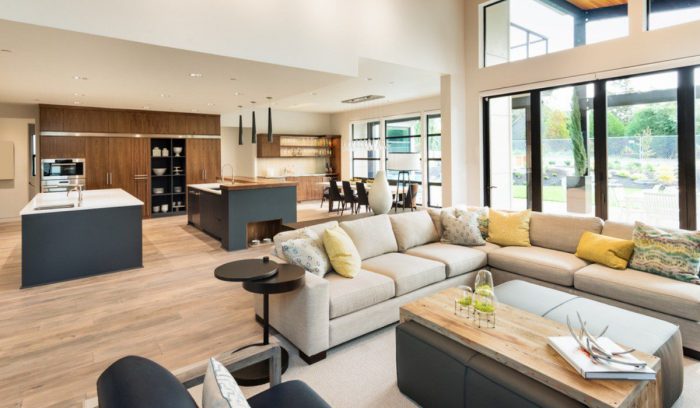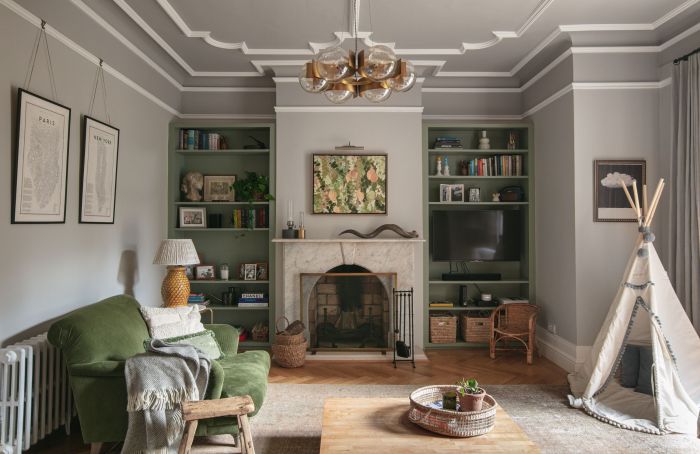Revamp Your Home with These Inspiring Home Design Ideas
Home design ideas set the stage for this enthralling narrative, offering readers a glimpse into a story that is rich in detail and brimming with originality from the outset. From popular styles to innovative trends and creative space planning, this exploration will guide you through the endless possibilities of transforming your living space.
Get ready to dive into a world where colors, lighting, and layouts converge to create a harmonious blend of aesthetics and functionality. Let's embark on this journey together and unlock the secrets to designing a home that truly reflects your personality and style.
Popular Home Design Styles
When it comes to home design, there are several popular styles that homeowners often choose from to create a cohesive and aesthetically pleasing living space. Each style has its own unique features and elements that set it apart from the rest.
Let's explore some of the most popular home design styles and how they can be incorporated into different rooms in a house.
Modern
The modern home design style is characterized by clean lines, open spaces, and a minimalist approach. Key features include neutral colors, sleek furniture, and an emphasis on simplicity. In a living room, you can incorporate the modern style by choosing furniture with straight lines, opting for a neutral color palette, and adding in pops of color through accent pieces like throw pillows or artwork.
Traditional
Traditional home design is classic and timeless, featuring ornate details, rich colors, and elegant furniture. Elements of this style include intricate moldings, dark wood finishes, and luxurious fabrics. To bring a traditional touch to a bedroom, you can use a four-poster bed, add in plush bedding, and incorporate antique accents like a vintage mirror or chandelier.
Minimalist
The minimalist style focuses on simplicity and functionality, with an emphasis on clean, uncluttered spaces. This style often features neutral colors, simple furniture, and plenty of natural light. To create a minimalist kitchen, you can opt for sleek cabinets, minimalistic countertops, and open shelving to showcase essential items while keeping the space clutter-free.
Farmhouse
Farmhouse style is cozy and inviting, with a mix of rustic and modern elements. This style often includes wood accents, vintage decor, and a warm color palette. To infuse a farmhouse feel into a dining room, you can use a farmhouse table, mix and match chairs, and add in elements like a rustic chandelier or a vintage rug for added charm.
Innovative Home Design Trends
In today's ever-evolving world of home design, there are several innovative trends that are shaping the way we live and interact with our living spaces. From sustainable materials to smart home technology, these trends offer a glimpse into the future of home design.When it comes to integrating these trends into home design, there are both benefits and challenges.
Sustainable materials, for example, not only help reduce our environmental impact but also create a healthier living environment. However, the initial cost and availability of these materials can sometimes pose challenges for homeowners. Similarly, smart home technology offers convenience and efficiency, but the complexity of integrating these systems seamlessly into a home design can be daunting.One example of innovative design solutions that incorporate these trends is the rise of indoor-outdoor living spaces.
By blurring the lines between the indoors and outdoors, homeowners can create a seamless flow between their living spaces, allowing for a closer connection to nature and a more open, airy feel to their homes. This trend not only enhances the aesthetic appeal of a home but also promotes a healthier lifestyle by encouraging more time spent outdoors.
Sustainable Materials
Using sustainable materials in home design not only reduces the environmental impact of construction but also creates a healthier living environment for occupants. Examples of sustainable materials include bamboo flooring, reclaimed wood, recycled glass countertops, and energy-efficient insulation.
Smart Home Technology
Smart home technology allows homeowners to control various aspects of their home, such as lighting, temperature, security, and entertainment, through connected devices. Examples of smart home technology include smart thermostats, automated lighting systems, security cameras, and voice-controlled assistants.
Indoor-Outdoor Living Spaces
Indoor-outdoor living spaces blur the lines between the indoors and outdoors, creating a seamless flow between the two. Examples of indoor-outdoor living spaces include sliding glass doors that open up to a patio or deck, outdoor kitchens with built-in seating, and garden rooms that bring the outdoors inside.
Creative Space Planning Ideas

Creating a sense of spaciousness and functionality in small homes or apartments requires creative space planning ideas. By exploring innovative ways to maximize space, incorporate open floor plans, utilize multi-functional furniture, and implement built-in storage solutions, you can transform any space into a stylish and practical living area.
Open Floor Plans
Open floor plans are a popular choice for small homes as they create a sense of spaciousness by eliminating unnecessary walls and barriers. This design concept allows for better flow between rooms, making the space feel larger and more inviting.
To maximize the benefits of an open floor plan, consider using furniture strategically to define different areas within the space without cluttering it.
Multi-functional Furniture
Incorporating multi-functional furniture is a key element in creative space planning. Look for pieces that serve dual purposes, such as a sofa bed, storage ottoman, or extendable dining table. These versatile pieces not only save space but also add functionality to your home.
Additionally, consider furniture with built-in storage compartments to minimize clutter and maximize storage capacity.
Built-in Storage Solutions
Built-in storage solutions are essential for optimizing space in small homes. Utilize vertical space by installing floor-to-ceiling shelves, cabinets, or built-in closets to maximize storage capacity without sacrificing floor space
Color Schemes and Mood Boards
When it comes to home design, color plays a crucial role in setting the mood and atmosphere of a space. Different colors evoke different emotions and can greatly impact how we feel in a room. Choosing the right color scheme can transform a space and create the desired ambiance.
Impact of Colors on Mood and Atmosphere
Color psychology is a powerful tool in interior design. Warm colors like red, orange, and yellow are known to energize and create a cozy atmosphere, perfect for living rooms or dining areas. On the other hand, cool colors like blue, green, and purple have a calming effect and are ideal for bedrooms or home offices.
Neutral colors like white, beige, and gray provide a sense of balance and can be used as a base for any color scheme.
Sample Mood Boards for Different Color Schemes
- Monochromatic Color Scheme: A monochromatic color scheme involves using variations of a single color. For example, a room with different shades of blue can create a harmonious and soothing environment.
- Complementary Color Scheme: Complementary colors are opposite each other on the color wheel, such as blue and orange or red and green. This scheme creates a vibrant and dynamic look in a space.
- Analogous Color Scheme: Analogous colors are next to each other on the color wheel, like blue, green, and teal. This scheme offers a cohesive and harmonious feel in a room.
Choosing the Right Color Palette for Different Rooms
When selecting a color palette for a room, consider the purpose of the space. For example, vibrant and energizing colors are suitable for areas where you entertain guests, while calming and soothing colors work well in bedrooms for relaxation. It's essential to think about how you want to feel in each room and choose colors that support that mood.
Lighting Design Techniques

Lighting plays a crucial role in home design as it not only illuminates the space but also sets the overall ambiance and mood. Proper lighting design can enhance the functionality and aesthetics of a room, making it more inviting and comfortable.
Comparison of Lighting Fixtures
When it comes to lighting fixtures, there are various options available, each serving a different purpose and creating a unique look. Here is a comparison of some common lighting fixtures:
- Recessed Lights: These fixtures are versatile and can be used for general lighting or highlighting specific areas in a room.
- Pendant Lights: Perfect for adding a decorative touch and providing focused task lighting, especially over kitchen islands or dining tables.
- Sconces: Ideal for creating ambient lighting and adding a decorative element to walls, hallways, or bathrooms.
Layering Lighting for Functionality and Aesthetics
Layering lighting involves using different types of fixtures at varying levels to create a well-balanced and visually appealing lighting scheme. Here are some tips on how to layer lighting effectively in different spaces:
- Start with ambient lighting to provide overall illumination in the room.
- Add task lighting for specific activities such as reading or cooking.
- Incorporate accent lighting to highlight architectural features or artwork.
- Consider using dimmers to adjust the light intensity based on the time of day or mood.
Epilogue

As we conclude our exploration of home design ideas, remember that the key to a well-designed home lies in the details. By incorporating elements from various styles, embracing innovative trends, and optimizing your space creatively, you can craft a living space that is not only visually appealing but also tailored to your needs.
Let your imagination soar as you embark on this design journey, and may your home be a reflection of your unique personality and taste.
User Queries
How do I choose the right color palette for my living room?
To choose the right color palette for your living room, consider the mood you want to create, the size of the room, and the natural light it receives. Neutral tones like beige or gray are versatile options that can be easily complemented with accent colors.
What are some innovative trends in home design that are gaining popularity?
Some innovative trends in home design that are gaining popularity include sustainable materials, biophilic design, and the integration of smart home technology for increased convenience and energy efficiency.
How can I create a sense of spaciousness in a small apartment?
To create a sense of spaciousness in a small apartment, utilize light colors, mirrors to reflect light, and multi-functional furniture that maximizes space. Additionally, keeping the space clutter-free and incorporating smart storage solutions can help open up the area.




